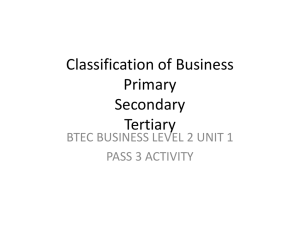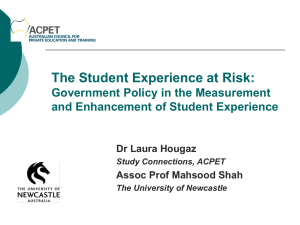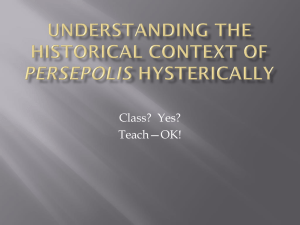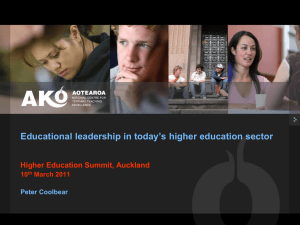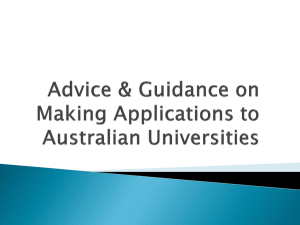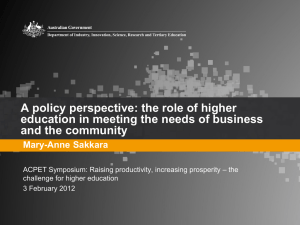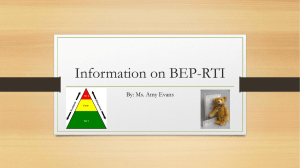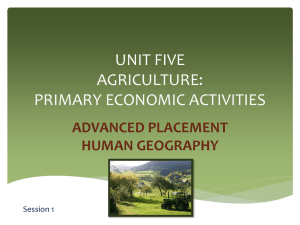Re-moralising Quality Assurance in Private Tertiary Education
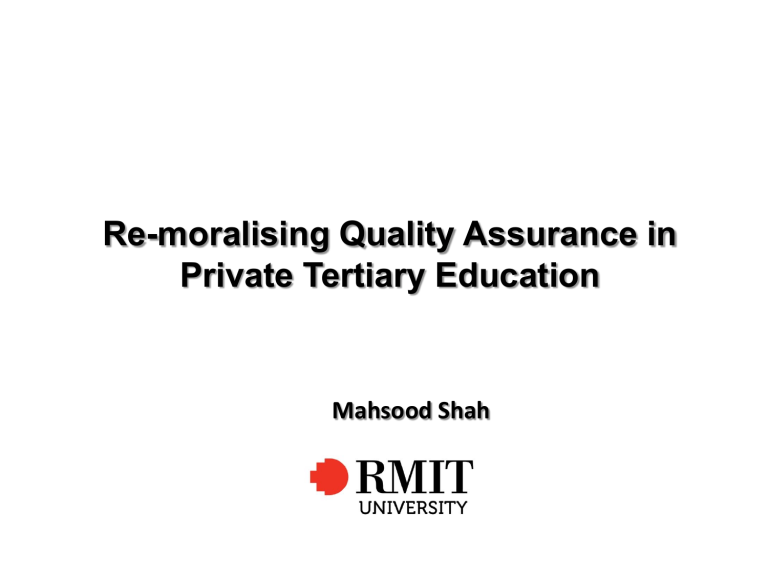
Re-moralising Quality Assurance in
Private Tertiary Education
Mahsood Shah
Presentation at Glance
Rationale of the topic
Brief about private tertiary education
QA practices in private tertiary education
Current dilemma
Multiple QA frameworks and challenges
Does QA matter?
Summary
Research on private tertiary education: what is known?
Questions and discussion
2
Rationale of the topic
What is the moral purpose of tertiary education?
Help build a fairer, more just society
Fulfilling the social responsibility of education
Economic responsibility and productivity
Tackling contemporary issues facing society
Graduates are able to do their job effectively
Knowledge is used to improve the human condition e.t.c.
3
Rationale of the topic….
Defining quality: excellence (high standards); perfection
(zero defects); value for money (return on investment); transformation (process of change), (Harvey and Green,
1993)
Is quality a moral purpose of tertiary providers?
Social responsibility
Economic responsibility
Tertiary education productivity
Stakeholder needs and expectations
Guarding against declined standards: intellectual, ethical and moral McWilliam (2004)
4
Brief about private tertiary education
Ongoing growth e.g. private higher education (20%)
Significant investment in online learning
Innovative marketing strategies
Mergers and acquisitions
Competitive
Engagement with industry
Collaboration with public universities
Student choice is clearly informed
Different student experience
Unclear future: government policy directions
5
QA practices in private tertiary education
Internal QA driven by external requirements
In some cases compliance driven QA inherited by AQTF and move from VET > HE
Compliance vs improvement led approach
Conflict between Academic Quality and Growth/Profi t
Growth has in some cases compromised Quality
Concerns raised in AUQA audit reports (Winchester, 2010;
Shah and Lewis, 2010; and Shah and Nair, 2011)
QA concerns in international literature
6
Questioning QA in Tertiary Education >
Public and Private
Student assessments, soft marking and grading
Student complaints about the quality of education
Declining student experience
Closure of various providers without notifying students
Employer complaints about the quality of graduates
Quality assurance practices in offshore international education
Academic and non-academic support for students
Staff engagement with quality and improvement;
How about social inclusion agenda and issues around access and participation of disadvantaged student???
7
Current dilemma
Use of different framework
TEQSA (provider standards, AQF, ESOS, CRICOS, other???)
ASQA (VET quality framework)
NEAS
ISO
Mostly driven by compliance culture
Process driven > good processes are easy to achieve then good outcomes
Absence of a single framework in institutions to meet VET,
HE and English language requirement
Excessive focus on paperwork and documentation
8
Current dilemma…..
Reactive to government policy changes rather then building internal capacity
Compliance driven QA raises important questions on the extent to which quality is tracked and improved in a systematic manner in important areas such as:
course design
course reviews
teaching quality
quality and standard of student assessments
student attainment of learning outcomes
comparability in academic outcomes and the student experience with courses taught at different locations and modes of delivery.
9
Current dilemma…..
ISO 9001 - 2008 Certification
10
18
28
Note: the data used in figure 1 is from JAS-ANZ online database http://cab.jasanz.org/CABPublic/Pages/PublicSearch.aspx
as of August 2012.
Private providers
TAFE Institutes
Universities
10
Current dilemma…..
Cost of managing quality and accreditations
Quality Assurance Framework Approximate cost
TEQSA registration and reaccreditation $70,000
ASQA registration and reaccreditation $10,800*
NEAS registration and reaccreditation $12,000
ISO registration and reaccreditation $77,000
Total cost $169,000
* Initial registration as an RTO and CRICOS registration application of up to 10 qualification and 2 delivery sites
11
Recurring themes > AUQA and others
Academic governance
Compliance led QA
Academic leadership
Huge reliance on sessional teachers – coordination of courses
Research culture
Access for disadvantaged students
Reliance on international student income
Staff professional development
Academic support structures
Alignment between growth and resourcing (e.g. library)
Data and performance monitoring
12
Multiple QA frameworks and challenges
Higher Education
Problem identified in Bradley review – inconsistent implementation of National Protocols
Performance monitoring and reporting
AUQA’s failure to monitor standards and compliance with external reference points.
13
Multiple QA frameworks and challenges..
AQTF
Lack of consistent implementation
Lack of compliance to AQTF standards by providers (Abola and Lambert, 2010; Gallagher and Anderson, 2005; Myer and Blom, 2004)
AQTF quality indicators: compliance and national findings?
Lack of risk based audits resulted in the collapse of more than 10 private VET colleges
14
Multiple QA frameworks and challenges..
ISO 9000
Marketing tool use to improve brand/image - used in education institutions who subscribe to the image of university as business
(Houston, 2007)
Less than 25% US Colleges used ISO in Learning and Teaching
(Vazzana et al, 2000)
More focus on processes and documentation (Bevans-Gonzales and Nair, 2004; Waks and Moti, 1999)
Confusion among staff on how ISO is applied in tertiary education(Bevans-Gonzales and Nair, 2004)
A survey of 647 companies in UK shows only 15% benefited from ISO (Vanguard consulting Ltd, 1994)
15
Multiple QA frameworks and challenges..
ISO 9000
According to Alderman (1999), ‘quality in tertiary education is not about satisfying the customer (i.e. the student), but is rather about transforming learners, which is not the same thing at all ... an ISO 9000 approach will not and cannot lead, by itself, to the achievement of quality: the most it can lead to is short-to medium, to mid-term bureaucratic procedural compliance’ (p.262).
16
Does QA matter?
Reputation of Australian tertiary education
Increased regulation of tertiary education
Use of ranking and leagues tables to assess institutional performance
Marketisation and student choice
Competition
Tertiary education productivity: from success to excellence
My PrivateCollege??
Governments political agenda: social inclusion, performance funding, quality and productivity
17
Moral dilemma
Higher education institutions are losing sight of their ethical functions in their desire to turn a profit (Schwartz (2011)
Moral imperative on an institution to do most it can to facilitate the learning of its students and the external clients (York, 2000)
Failure of students and declined standards -intellectual, ethical and moral (McWilliams, 2004)
Low access and participation of disadvantaged students raises questions on the moral purpose of tertiary education
(Shah and Nair, forthcoming)
18
Summary
Growth of the sector
Student experience>
Student choice
Practical education
Size
Relationship with industry
Student experience
Industry based teaching staff
Ease of entry
Location
Profile of students
Flexibility (online, distance, part time, fast track)
19
Summary
Sustainable QA
Single framework to meet VET and HE
Internal QA and capacity building
AQF challenge
Growth should not compromise quality outcomes and the student experience
Time to revisit QA arrangements - shift from compliance to an improve led approach
High risk providers and TEQSA > watch dog, sniffer dog or a guide dog??
Reputation of Australian tertiary education
20
Research on private tertiary education
Bennett, L., Nair, S., & Shah, M. (2012). The Emergence of Private Higher Education in Australia: The Silent Provider .
European Journal of Higher Education, forthcoming
Shah, M., Nair, S., & Bennett, L. (2012). Factors Influencing Student Choice to Study at Private for-profit Higher Education
Institutions.
Quality Assurance in Education, forthcoming
Nair, S., Bennett, L., and Shah, M. (2012). Student Experience: A Private Provider Perspective. The ACPET Journal for
Private Higher Education, forthcoming
Shah, M., & Nair, S. (2012). A New Dynamic in Australian Higher Education: The Emergence of Private for-profit Higher
Education. European Journal of Higher Education, available in late 2012
Shah, M., & Nair, S. (2012). Private for
–profit higher education in Australia: Widening Access and Participation and
Opportunities for Public-Private Collaboration. Higher Education Research and Development Society (HERDSA), available in late 2012 or early 2013
Shah, M., Nair, S. (2011). Building the plane while it's flying: enhancing the missed opportunity for quality assurance and capacity-building in Australian private higher education. European Journal of Higher Education , 1 (2-3), 261-273.
Shah, M., & Nair, S. (2011). Engaging with Quality: Quality Assurance and Capacity Building in Private Higher Education.
Australian Quality Forum 2011, 138-144. Melbourne: Australian University Quality Agency.
Shah, M., & Lewis, l. (2010). Private Higher Education in Australia: Growth, Quality and Standards. Journal of Institutional
Research (South East Asia) , 8 (2), 80-95.
Shah, M., & Brown, G. (2009). The Rise of Private Higher Education in Australia: Maintaining Quality Outcomes and Future
Challenges. Proceedings of the Australian Universities Quality Forum (AUQF) , 138-143. Melbourne: Australian Universities
Quality Agency.
21
shah_mahsood@hotmail.com
22
